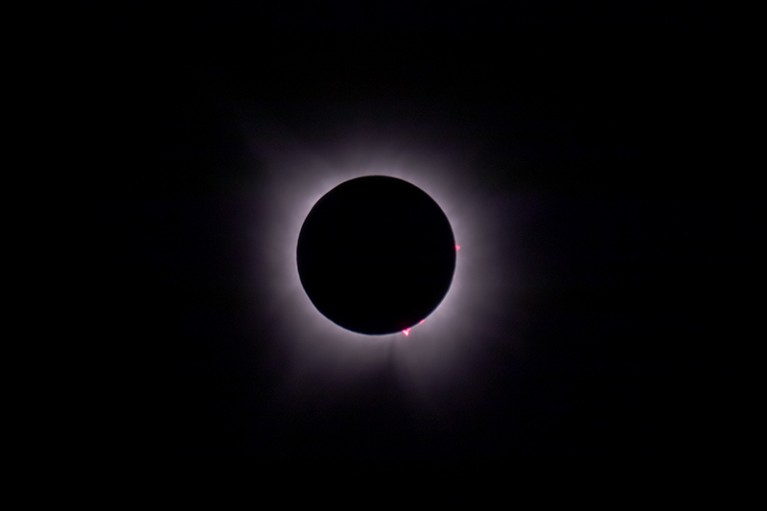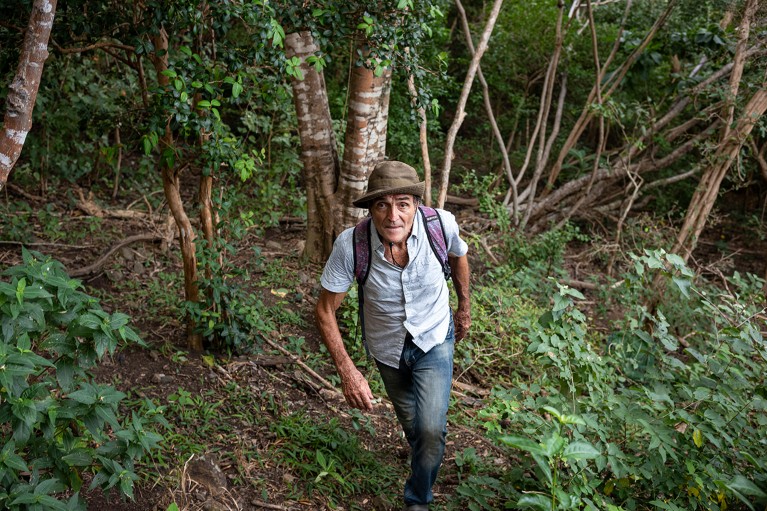[ad_1]
Hello Nature readers, would you like to get this Briefing in your inbox free every day? Sign up here.

Bright red spots called prominences appeared along the solar disk during the total eclipse.Credit: Sumeet Kulkarni/Nature
Yesterday’s total eclipse stunned skywatchers. “It makes your heart want to skip a beat, and you cannot really describe it to someone who hasn’t experienced it in person,” retired educator Lynnice Carter told Nature. Some people could spot impressive solar prominences as reddish dots around the edges of the moon’s shadow. Prominences are enormous loops of plasma, many times bigger than Earth, that can last several months. They often appear red because they contain hydrogen glowing at extremely high temperatures.
Scientific American | 4 min read

Thank you to everyone who’s shared their eclipse images with us! Connie Friedman’s view from a canoe on Lake Erie, Beth Peshkin’s portrait of Carly the dog putting safety first and Les Jones’s image of totality in Kingston, Canada, are among our favourites so far.
Modern Blackfoot people are closely related to the first humans that populated the Americas after the last ice age. DNA analysis of six modern and seven historic individuals shows that they belong to a previously undescribed genetic lineage that extends back to more than 18,000 years ago. The data add to evidence from Blackfoot oral traditions and archaeological findings, and could support the claims that these people have to ancestral lands.
Reference: Science Advances paper
Some scientists in Brazil say their labs won’t have enough money to cover basic expenses such as electricity and water unless more funding is found. Institutions in the Amazon argue that they are the hardest hit because their federal support is already disproportionately low. President Luiz Inácio Lula da Silva’s administration is fighting to reverse some of the budget cuts imposed by the country’s legislators.
Features & opinion
The very different ways that communities of desert ants and forest ants find their food demonstrates how our unpredictably messy world drives the evolution of social behaviours, argues biologist Deborah Gordon in The Ecology of Collective Behavior. The idea is not as contentious as Gordon makes out, writes reviewer and ecologist Seirian Sumner. But it still highlights a crucial point: “The interactions between organisms and their environments have become increasingly overlooked because fewer researchers are studying animals in their natural environments.”
“I tried to compensate for my disability by working longer hours,” recalls biochemist Kamini Govender, who has a condition that severely affects her peripheral vision. She developed coping strategies, but ended up working at an unsustainable pace. “Over time, I have learnt to practise better self-care by knowing when to stop.” More needs to be done to include people with disabilities, Govender says. “In the sciences, few of these people make it to the level that I have, because of all the hurdles they come across. It’s easier to quit and give up.”
Several student-led groups and conferences are working to ensure that they have a part in determining AI’s role in education. Students recognize that the technology can be a double-edged sword, but caution against knee-jerk blanket bans. “In talking to lecturers, I noticed that there’s a gap between what educators think students do with ChatGPT and what students actually do,” says computer science student Johnny Chang.
Where I work

Dario Sandrini is director of the KIDO Foundation, Carriacou Island, Grenadines of Grenada.Credit: Micah B Rubin for Nature
Dario Sandrini’s environment and education foundation, KIDO, has run around 30 projects on the small Caribbean island of Carriacou — from protecting sea turtles to replanting mangroves. He’s now working on restoring areas that have been logged, in some cases, illegally. “With another ten years of care, we will see the forest resurge,” he says. (Nature | 3 min read)
Today, I’m enjoying biologist-comedian Adam Ruben’s musings on those physically repetitive tasks that are part of many scientists’ lives. “So many accomplishments in science are vaporous,” Ruben writes. Although manual lab work can be unbelievably boring, it can also be incredibly satisfying. “It meant I had accomplished something tangible,” he says.
Please tell me about your favourite dull (lab) tasks, alongside any other feedback on this newsletter, by sending an email to [email protected].
Thanks for reading,
Katrina Krämer, associate editor, Nature Briefing
With contributions by Flora Graham and Sarah Tomlin
Want more? Sign up to our other free Nature Briefing newsletters:
• Nature Briefing: Anthropocene — climate change, biodiversity, sustainability and geoengineering
• Nature Briefing: AI & Robotics — 100% written by humans, of course
• Nature Briefing: Cancer — a weekly newsletter written with cancer researchers in mind
• Nature Briefing: Translational Research covers biotechnology, drug discovery and pharma
[ad_2]
Source Article Link

